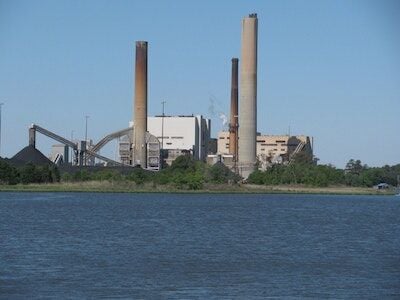Delaware electric utilities received a more than $25 million refund from a regional energy producer earlier this year. Now, they are tasked with passing those savings on to customers across the state who overpaid for electricity.
In January, NRG, a major energy producer in the region, settled a complaint that it overcharged Delaware utilities as part of its contract to keep the coal-powered unit at Indian River Power Plant open.
Now, the state’s electric providers are returning those savings back to the customers who originally footed the increased bills by providing rate adjustments, improving infrastructure and even issuing direct refunds.
“We were pleased with the outcome,” said Matt Hartigan, spokesperson for the Delaware Public Service Commission, which regulates the state’s for-profit utilities and led the charge on returning the money. “It lowered the rate … to something that we thought was more fair.”
The refund was split based on the amount of energy each utility used.
According to the Delaware Public Service Commission, Delmarva Power received $10.9 million, the Delaware Municipal Electric Corporation (DEMEC) received $3.3 million, the Delaware Electric Cooperative (DEC) received $5.6 million and third party suppliers, which provide electricity to consumers using Delmarva infrastructure, received $5.6 million.
Delawareans who get power from either Delmarva or the DEC received smaller bills earlier this year after the utilities both used their refunds to lower rates. But for some residents, the benefits of the refund remain to be seen.
Why were residents overcharged?
In 2021, NRG notified the regional electric grid operator, PJM, of its plan to close the coal-fired Indian River Power Plant.
But PJM determined it needed that section of Indian River to stay operational while Delmarva Power made infrastructure upgrades to offset the loss of power supply in the grid.
 A map of the country’s electric electric grid operators. The mid-Atlantic and portions of the Midwest are operated by PJM.
A map of the country’s electric electric grid operators. The mid-Atlantic and portions of the Midwest are operated by PJM.NRG agreed to keep the section of Indian River running, as long as customers in the area paid a special electric rate to cover the costs at the plant that was no longer profitable.
These arrangements have faced criticism for favoring electric producers, like NRG, which have “significant market power” when their resource is in demand. Producers then use that power to sometimes ask for more money than they actually need.
The Delaware Public Service Commission and other stakeholders accused NRG of doing exactly that, filing a complaint with the Federal Energy Regulatory Commission saying NRG’s special rate was too high.
That complaint resulted in the $25 million settlement to Delaware utilities, which was approved in January.
PJM’s Independent Market Monitor, which advocates for electricity market fairness, opposed the settlement, saying NRG should have paid more.
“We understand their perspective, but thought this was our best chance of success,” said Hartigan, with the Delaware Public Service Commission. “This was the best we thought we could do.”
The section of the Indian River plant that spurred this year’s refund closed in February, a spokesperson with NRG said. Only one section of the plant is still operational, with a retirement date scheduled for June 2026.
DEMEC municipalities face a decision
DEMEC split its $3.3 million refund among its member municipalities — Clayton, Lewes, Middletown, Milford, New Castle, Newark, Seaford and Smyrna — based on how much power they purchased while the increased rate was in effect.
Now, each member municipality must decide what to do with that refund.
New Castle is the only municipality that has made a final decision on what to do with its $182,000 refund. It will return that money to customers through a refund on their August bills based on power usage last month, the city wrote in a Facebook post.
Milford plans to use the same approach with its refund of about $588,000, but the details are still being worked out, Community Engagement Manager Lauren Swain said.
Newark received the largest refund of all DEMEC members at about $1 million. On Monday, Newark City Council considered a proposal to use the money to help pay for a new electric substation that is needed in the city.
The council did not vote on the idea, but Newark Councilwoman Corinth Ford said during the meeting she thought the substation “would be a good candidate [for the money], because we could borrow less.”
Clayton Town Manager Paul Johnson Sr. said the town is considering using its nearly $57,000 refund to help pay for an advanced electric monitoring system so residents can save power during peak times.
Johnson said the town is still deciding what will benefit residents the most, a small one time rate decrease or new infrastructure that would help residents save money in the long term.
“But it will, without a doubt, 100% go back to the electric system,” Johnson said.
Seaford received almost $283,000. City Manager Charles Anderson said the city will likely use the money to offset any potential electricity rate increases next year.
Lewes’ Board of Public Works will likely discuss what to do with the city’s approximately $208,000 refund in September or October, according to the board’s Assistant General Manager Sharon Sexton.
Representatives from both Middletown and Smyrna did not respond to multiple requests for comment about their respective plans.











(0) comments
Welcome to the discussion.
Log In
Keep it Clean. Please avoid obscene, vulgar, lewd, racist or sexually-oriented language.
PLEASE TURN OFF YOUR CAPS LOCK.
Don't Threaten. Threats of harming another person will not be tolerated.
Be Truthful. Don't knowingly lie about anyone or anything.
Be Nice. No racism, sexism or any sort of -ism that is degrading to another person.
Be Proactive. Use the 'Report' link on each comment to let us know of abusive posts.
Share with Us. We'd love to hear eyewitness accounts, the history behind an article.